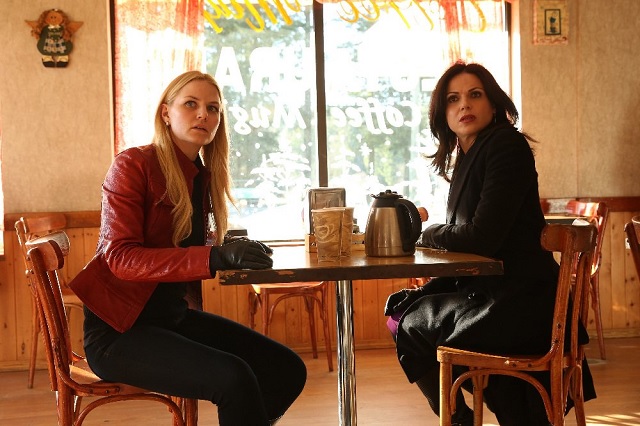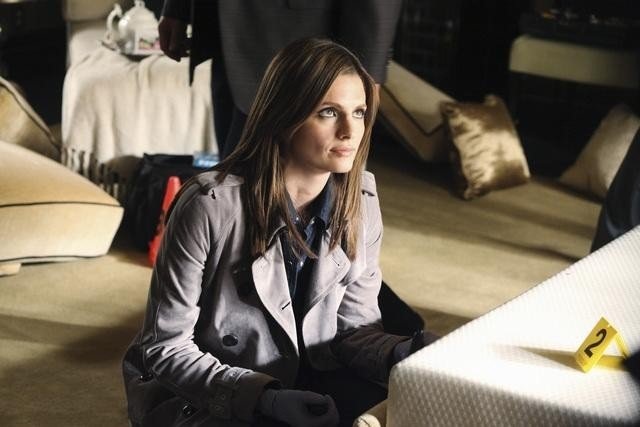Shows with female leads or co-leads now have a strong presence on network television, as representations of women in lead roles has grown in leaps and bounds over the past few years. The complexity and multi-dimensionality of these roles varies greatly, however, and on more than a few network shows, female leads continue to be idealized and/or isolated from other women. It’s been ensemble genre shows (along with one longstanding drama staple), that have had a chance to shine in this area, as they portray female characters who are strong, and flawed, and portrayed as having relationships with other women. It’s a formula that feels increasingly right and necessary in a 21st-century world in which women expect to see both themselves, and women they can aspire to be, represented on the small screen.
Take, for example, the case of ABC’s procedural Castle. As creatively consistent and as well-loved as Castle has been for much of its run, it’s characterized by a trope that has popped up more often as women characters increase in number: that of a female lead or character who is so immensely capable in every way that she’s nearly without flaw. I term these characters ‘Superwomen’. The Castle writers have always shied away from making Kate Beckett anything less than nearly perfect. She’s the woman you wish you were, and more particularly the woman most men probably imagine and would wish for. Beckett isn’t just beautiful, brilliant, and a successful cop. She’s also moonlighted as a model in the past, loves baseball, crime films, and riding her ’94 Harley, and has often hinted at a sexually wild past. She effortlessly leads an all-male team at the precinct. She can be a classic guy’s girl, yet she also cleans up real good and connects effortlessly with women too—Martha, Lainie, Alexis and more. She even gives Castle on-point parenting advice, despite never having been a parent herself.
The only genuine flaw the writers allow her to have is an emotional distance in romantic relationships, and even that fades after she begins dating Castle. Kate Beckett is, in many respects, what Gillian Flynn described in Gone Girl: a woman who is an amalgam of the best traits of other women, someone too perfect to be real. Scandal‘s Olivia Pope and Agents of S.H.I.E.L.D‘s Melinda May also fall in this category to one extent or another.
Another category some network shows assign their female characters to is that of the isolated heroine. This is seen in shows that revolve around a complicated woman, but neglect to place any other women around her. The Mindy Project is an egregious example of this, in that Mindy Lahiri lives in a world entirely populated by men. For the last two seasons, almost every single one of her significant interactions, friendships, and relationships have been with men. She has no mother, no sister, no female best friend, no female coworker whom she actually talks to—every single role in her life is filled by a male.
CBS’ Elementary poses the same scenario—Joan Watson has a best friend and coworker in Sherlock, a friend in Marcus Bell, and a boss/friend in Captain Gregson, but actively distances herself from, or at most begrudgingly spends time with, female friends and her mother. Mindy and Joan are not Superwomen or Cool Girls; the former is flighty and occasionally ridiculous, the latter intensely private and controlling of her own life. They are believably and relatably flawed, but they are also representations of women that limit who women are.
Grey’s Anatomy, on the other hand has, for its decade-long run, always been a shining example of how to write women boldly and with complexity, even placing them in relationships with other women. The friendship between Meredith Grey and Cristina Yang is a seminal example of this: two brilliant women whose slow burn toward absolute trust and friendship was a touchstone of the story, and who, episode by episode, could be Superwomen for a moment in the operating room or ER, and then turn around and do something so stupid that they leaped off the screen with vivid realism.
But it’s mainly genre shows in the past couple of years that have provided a home to women, and quietly been revelatory about how they can be portrayed. ABC’s Once Upon a Time is both female-led and gives center stage to the relationships between women. Heroine Emma Swan has complex, constantly-shifting relationships with her mother Snow White, her ex-nemesis/sometime friend Regina, and her friends Belle, Elsa, and others over the course of the show’s history. The reluctant respect and push-pull nature of the relationship with Regina in particular is given the kind of screen-time and detail usually reserved for opposite-sex romantic relationships on other shows.
In addition, Emma is delightfully multi-dimensional. She’s the “Savior” (hero) of the show, but she’s guarded, stubborn, and emotionally withdrawn, to the detriment of nearly all her relationships at one time or another. She’s an incredibly strong single mother, a brave fighter, and a defender of the weak, but she’s also someone a woman can look at and not just think “I want to be her,” but also think “part of me is her.”
Arrow and The Flash, while blazing a successful trail for small-screen comic book adaptations and remaking old, existing worlds into something new, have quietly done the same for their female characters. The geeky tech girl, for example, isn’t new—audiences have seen her in 24, with Chloe, and in NCIS, with Abby, among many others—but in these shows, she’s promoted to center stage plot-wise, and to romantic leading lady potential. Felicity Smoak was never supposed to be a leading lady, but Arrow showrunners, seeing the potential, let her blossom from side character to partner and romantic interest.
Both shows overturn traditional female interactions by having women who have little in common and who could easily be romantic rivals respond to each other with empathy and respect instead. Felicity and Sara Lance were friends, and when Felicity loses Oliver in a very real sense toward the end of season three (no spoilers here!), she goes running straight to Laurel for comfort. When Felicity guest-stars on The Flash, there is no sense of one brilliant woman being intimidated or threatened by another who possesses many of the same skills. Instead, Felicity and Caitlin bond immediately, and are shown doing each other several small favors over the course of the season. Caitlin and Iris, meanwhile, do not become romantic rivals for Barry’s affections, but instead quick friends, and one of the highlights of recent episodes has been Iris knocking a villain unconscious in defense of Caitlin.
The female relationships in Arrow and The Flash are real and consistent, and while not generally a central plot-point, they nonetheless manage to portray strong, flawed women being friendly and interacting with each other—and that is a rare and wonderful thing. It’s impossible to write this article without also giving a shout-out to the CW’s The 100, which features a magnificent treatment of women that makes them bold and quick-tempered, reckless and controlled, brave and cowardly, empathetic and ruthless—in short, an ensemble of impressively layered female characters.
These shows display an instinctive respect toward women, and a sense of freedom in not boxing in or idealizing them. Brooklyn Nine-Nine and Jane the Virgin, while not being genre shows, are underseen gems that also have wonderful, wonderfully rounded women. May the odds be ever in favor of these more encompassing treatments of women.





